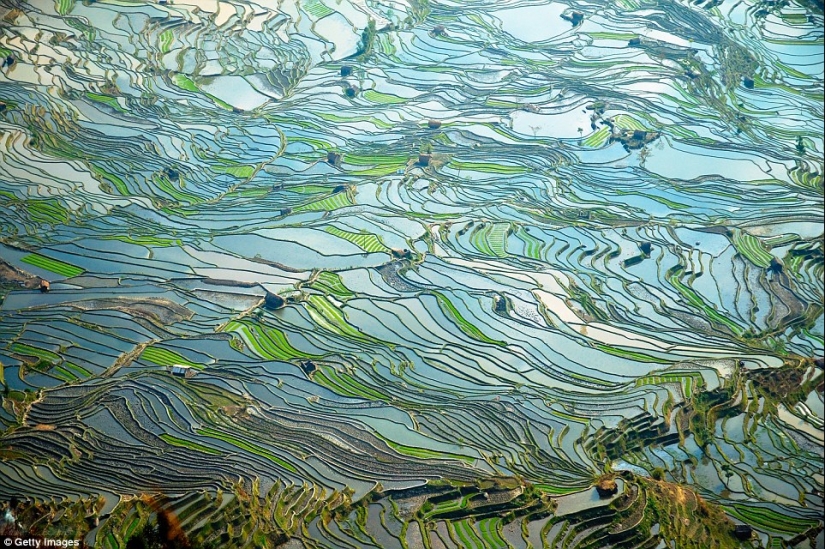Where did everyone go? The amazing beauty of China without tourists
Tourist spots in China can be even more crowded than a subway train at rush hour, and all because of the huge population. For example, a new glass bridge over the abyss opened in the south of China, but it had to be closed due to the endless flow of tourists, as the authorities fear that it simply may not withstand the load.
Nevertheless, judging by these fascinating pictures, there are rare moments and remote areas of the country where you will not meet a single living soul for many kilometers around. The photos were taken in picturesque places such as Dunhuang, an oasis on the edge of the Gobi Desert in northwest China, or Jiuzhaigou, a protected nature park in remote areas of Sichuan Province. Landscapes vary, but they have one thing in common: a sense of solitude and peace, as if you were the first in the whole world to see them.


Laohuzui Rice terraces in Yuanyang County, Yunnan Province. The place is included in the UNESCO World Heritage List. The terraces have been cultivated by the Han people for several millennia.

A lonely traveler in the Gobi Desert near the city of Dunhuang, which was once part of the Great Silk Road.

A traditional yurt used by the nomadic people of the Xinjiang Uygur Autonomous Okrug, against the backdrop of Mount Muztagata and Lake Karakul.

A bamboo raft floats on the Li River in southern China. This landscape is depicted on a 20 yuan banknote.

Wooden bridge in the Huanshan Mountains. This landscape in Anhui Province is often found in Chinese watercolors.

Kuitun Grand Canyon on the northern slope of Tien Shan Mountain in the Xinjiang Uygur Autonomous Region of China.

A lone climber climbs over rocky formations in the southwest of the Shilin-Yi Autonomous County.

Silted-up shores in Xiapu, a region in the southeast of Fujian Province, which is known for its traditional way of life. Many of its inhabitants still fish to provide for themselves.

Autumn beauty in the village of Hemu on the northern border of the Xinjiang Uygur Autonomous Okrug, where many live the same way as in the old days.

The water in the Yangtze tributary in the Dechen-Tibet Autonomous Region has risen strongly due to heavy rains.

A shepherd drives cattle through Altai meadows in the Xinjiang Uygur Autonomous Okrug during seasonal migration. Many pastoralists lead a traditional way of life, going higher into the mountains in summer, and descending to warmer meadows by winter.

An old fisherman in traditional clothes throws a net into the Li River. Next to him sits a cormorant, which helps him to fish.

In Baicheng County, after the harvest, red peppers were laid out to dry. These are very remote and ethnically diverse places.

Five Flowers Lake, also called Peacock Lake, in Jiuzhaigou Nature Reserve in autumn. Crystals at the bottom of the lake naturally reflect the bright colors of the surrounding landscape.

Yueyaquan Lake ("Growing Lake") in the Dunhuang Oasis is believed to have existed for more than two thousand years and is fed by water from a spring.

Danxia National Geopark is known for its multicolored mountains, which were formed due to layers of sandstone and sedimentary rocks.

A train with a steam locomotive travels along the railway connecting the cities of Ulanchab and Tongliao in Inner Mongolia.

Pearl Waterfall in Jiuzhaigou Nature Reserve is one of the most beautiful places in this park, which is often used for filming movies and television shows.

A Mongolian shepherd on the Bashan plateau in the northwest of the Chinese province of Hebei.

The Grand Canyon of Enshi in Hubei Province.

Woyun Temple on Mount Gezzaoshan in the Chinese province of Jiangxi.
Recent articles

On the eve of the New Year, a magical atmosphere reigns in every house — everything is hung with shiny tinsel, there is an ...

Motherhood significantly changes a woman's body. But there are more profound changes affecting the nature and Outlook. Reflected in ...

Some people have genetic abnormalities that make their appearance unique. These body features are usually inherited from parents, ...